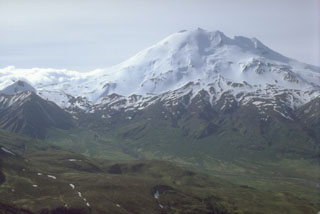Report on Chiginagak (United States) — March 1998
Bulletin of the Global Volcanism Network, vol. 23, no. 3 (March 1998)
Managing Editor: Richard Wunderman.
Chiginagak (United States) Gray clouds and sulfur smell indicate vigorous fumarolic activity
Please cite this report as:
Global Volcanism Program, 1998. Report on Chiginagak (United States) (Wunderman, R., ed.). Bulletin of the Global Volcanism Network, 23:3. Smithsonian Institution. https://doi.org/10.5479/si.GVP.BGVN199803-312110
Chiginagak
United States
57.135°N, 156.99°W; summit elev. 2221 m
All times are local (unless otherwise noted)
When scientists from the Alaska Volcano Observatory (AVO) conducted an overflight to Chiginagak on 11 March, the summit was visible but a thin cloud layer at about 1,700-1,900 m altitude obscured the fumarolic areas. Above the fumaroles, however, bulbous gray clouds penetrated through the thin cloud layer and extended to about 2,100 m altitude.
A strong sulfur smell was noticed 16-49 km downwind of the volcano. The gray clouds and sulfur smell supported observations from Pilot Point (60 km NW) that indicated continued vigorous fumarolic activity. Increased fumarolic activity has been reported at the volcano beginning as early as mid-1997 (BGVN 22:11 and 23:01). According to AVO, the increased activity did not imply an imminent eruption.
Geological Summary. The symmetrical, calc-alkaline Chiginagak stratovolcano located about 15 km NW of Chiginagak Bay contains a small summit crater, which is breached to the south, and one or more summit lava domes. Satellitic lava domes occur high on the NW and SE flanks of the glacier-mantled volcano. An unglaciated lava flow and an overlying pyroclastic-flow deposit extending east from the summit are the most recent products of Chiginagak. They most likely originated from a lava dome at 1687 m on the SE flank, 1 km from the summit of the volcano, which has variably been estimated to be from 2075 to 2221 m high. Brief ash eruptions were reported in July 1971 and August 1998. Fumarolic activity occurs at 1600 m elevation on the NE flank of the volcano, and two areas of hot-spring travertine deposition are located at the NW base of the volcano near Volcano Creek.
Information Contacts: Alaska Volcano Observatory (AVO), a cooperative program of a) U.S. Geological Survey, 4200 University Drive, Anchorage, AK 99508-4667, USA (URL: http://www.avo.alaska.edu/), b) Geophysical Institute, University of Alaska, PO Box 757320, Fairbanks, AK 99775-7320, USA, and c) Alaska Division of Geological & Geophysical Surveys, 794 University Ave., Suite 200, Fairbanks, AK 99709, USA.

